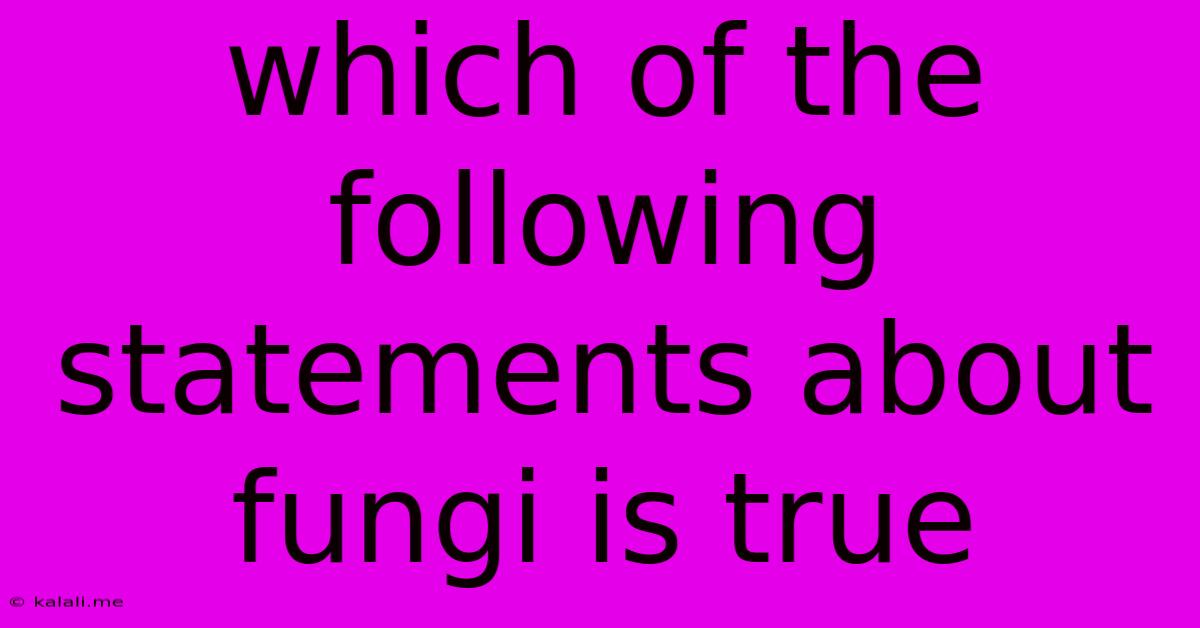Which Of The Following Statements About Fungi Is True
Kalali
Jun 15, 2025 · 3 min read

Table of Contents
Which of the Following Statements About Fungi is True? Deciphering the Mycological Mysteries
Fungi. These fascinating organisms, often overlooked, play a crucial role in our ecosystems and even our daily lives. From the delicious mushrooms on our plates to the unseen decomposers in the soil, fungi are everywhere. But how much do you really know about them? This article will explore common statements about fungi, separating fact from fiction and helping you understand these remarkable organisms better. We'll delve into their classification, reproduction, and ecological impact, ultimately answering the question: which statement about fungi is true?
Understanding the Kingdom Fungi: A Quick Overview
Before we tackle the true/false statements, let's establish a basic understanding. Fungi are eukaryotic organisms, meaning their cells contain a membrane-bound nucleus. Unlike plants, they don't photosynthesize; instead, they obtain nutrients through absorption, often by decomposing organic matter. This makes them vital in nutrient cycling within ecosystems. Their cell walls are composed of chitin, a substance also found in the exoskeletons of insects. Fungi exhibit a wide range of morphologies, from single-celled yeasts to complex multicellular structures like mushrooms. Understanding these fundamental characteristics will help us assess the accuracy of various statements.
Debunking Common Myths and Unveiling the Truth
Now, let's address some common statements about fungi and determine their validity:
Statement 1: All fungi are multicellular.
FALSE. While many fungi, such as mushrooms and molds, are multicellular, many others are unicellular, existing as single-celled organisms known as yeasts. Yeasts are crucial in various applications, including baking and brewing.
Statement 2: Fungi are plants.
FALSE. Fungi were once classified as plants, but they are now recognized as a separate kingdom entirely. Their distinct methods of nutrition (absorption versus photosynthesis) and cellular structures (chitinous cell walls versus cellulose cell walls) clearly differentiate them from plants.
Statement 3: Fungi reproduce only sexually.
FALSE. Fungi exhibit a remarkable diversity in their reproductive strategies. While sexual reproduction occurs in many fungi, involving the fusion of gametes, many also reproduce asexually through various mechanisms like budding (in yeasts), fragmentation, and spore production. Asexual reproduction allows for rapid colonization and adaptation to changing environments.
Statement 4: All fungi are harmful.
FALSE. While some fungi are indeed pathogenic, causing diseases in plants and animals, including humans, many others are beneficial. Many fungi are crucial decomposers, breaking down organic matter and recycling nutrients. Others are essential in food production (e.g., cheese, bread), medicine (e.g., penicillin), and even bioremediation (cleaning up pollutants).
Statement 5: Fungi are heterotrophic organisms.
TRUE. This statement accurately reflects the nutritional mode of fungi. Heterotrophs cannot produce their own food; instead, they obtain nutrients by absorbing organic matter from their surroundings. This absorption can occur through parasitic, saprophytic (decomposing), or symbiotic relationships.
Conclusion: The Mycological Truth
Understanding the intricacies of the fungal kingdom requires moving beyond simplistic generalizations. While certain characteristics are shared by many fungi, significant diversity exists in their morphology, reproduction, and ecological roles. Therefore, only Statement 5 – that fungi are heterotrophic organisms – is unequivocally true among the statements presented. The other statements highlight the complexity and diversity within the fungal kingdom, demonstrating that generalizations can be misleading when dealing with such a fascinating and varied group of organisms. Further exploration of mycology reveals an even deeper appreciation for their importance in our world.
Latest Posts
Latest Posts
-
The Panama Canal Connects To What Two Bodies Of Water
Jun 15, 2025
-
Find The Cubic Function With The Given Zeros
Jun 15, 2025
-
Boiling And Freezing Point Of Water
Jun 15, 2025
-
The Figure Shown Has A Total Area Of 168cm
Jun 15, 2025
-
Which Of The Following Is Not A Health Related Fitness Component
Jun 15, 2025
Related Post
Thank you for visiting our website which covers about Which Of The Following Statements About Fungi Is True . We hope the information provided has been useful to you. Feel free to contact us if you have any questions or need further assistance. See you next time and don't miss to bookmark.